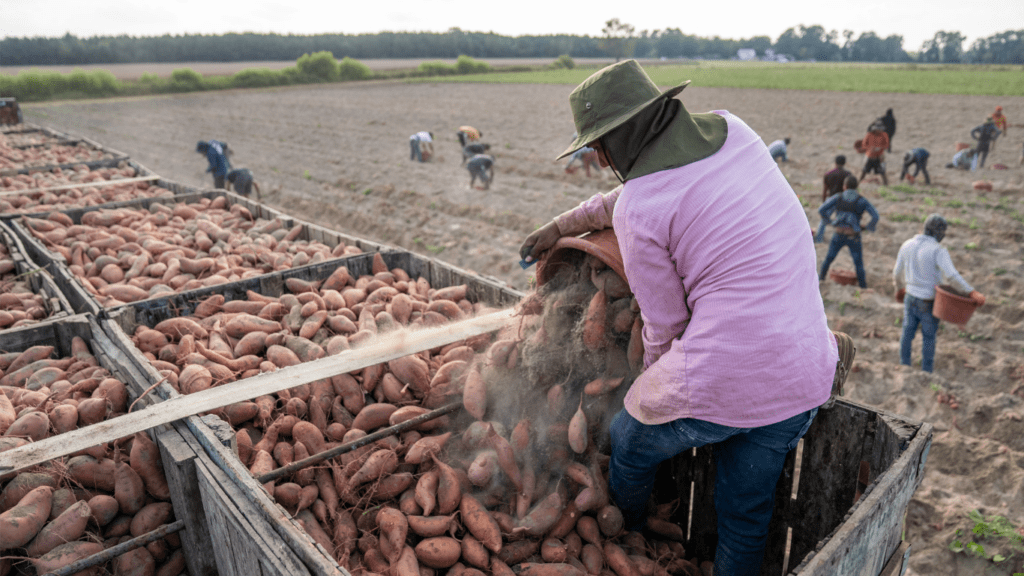Understanding GMOs in Agriculture
Genetically modified organisms (GMOs) play a significant role in modern agriculture. These organisms undergo genetic alterations to introduce desirable traits.
What Are GMOs?
GMOs are organisms whose genetic makeup has been modified through biotechnology. By inserting or removing genes, scientists create crops that exhibit specific traits like:
- pest resistance
- increased yield
- drought tolerance
For example, Bt corn contains a gene from the bacterium Bacillus thuringiensis, which produces a protein toxic to certain pests.
Historical Perspective on GMO Usage
GMOs have been part of agriculture since the early 1990s. The first genetically modified crop, the Flavr Savr tomato, gained approval in 1994. This tomato had a longer shelf life compared to conventional varieties.
Since then, GMO adoption has grown. By 2018, 94% of soybean and 92% of corn acres in the United States used GMO seeds, according to the USDA.
Efforts to improve crop resilience and productivity have driven GMO advancements. For instance, herbicide-resistant crops allow farmers to manage weeds more effectively, reducing labor and chemical use.
This technological evolution reflects ongoing efforts to address food security and environmental challenges in agriculture.
Current Trends in the GMO Market

GMO technology continues to evolve. Current trends show increasing adoption and diversification across various crops and regions.
Leading GMO Crops
GMO crops dominate several key agricultural markets. Corn, soybeans, and cotton represent the most widely grown genetically modified crops. For instance, in 2018, GMO variants of these crops accounted for over 90% of the total acreage in the United States.
Farmers select GMO crops due to their enhanced traits like pest resistance and herbicide tolerance, which lead to higher yields and lower costs.
Major Players in the Industry
Several companies lead the GMO market. Monsanto (acquired by Bayer in 2018), Syngenta, and DuPont stand as the major players. These corporations invest heavily in research and development to innovate and expand their GMO product lines.
For example, Monsanto developed the Roundup Ready crops, which tolerate the herbicide glyphosate, simplifying weed control. Syngenta’s Agrisure and DuPont’s Pioneer also offer competitive GMO seed varieties that address various agricultural challenges.
Benefits of GMOs
Genetically modified organisms (GMOs) offer numerous advantages in agriculture, significantly impacting crop production and sustainability.
Increased Crop Yields
GMOs improve crop yields by enhancing traits like drought tolerance and nutrient efficiency. For example, biotech crops like Bt corn increase farmers’ productivity by reducing crop losses.
According to the International Service for the Acquisition of Agri-biotech Applications (ISAAA), between 1996 and 2018, crop yields increased by 37% globally due to GMO adoption.
Pest and Disease Resistance
GMOs deter pests and diseases, reducing the need for chemical pesticides. Crops like Bt cotton produce proteins that target specific insects, limiting pest damage.
This technology not only protects crops but also minimizes environmental impact by decreasing pesticide usage. The Environmental Protection Agency (EPA) reports that Bt crops reduce insecticide use by 8.8 million pounds annually in the United States.
Concerns and Controversies
Despite the advantages of GMOs, several concerns and controversies persist. These revolve around environmental impact, health issues, and ethical considerations.
Environmental Impact
Environmental impact remains a crucial concern with GMOs. Genetically modified crops can lead to reduced biodiversity, as they often favor monocultures. Monocultures reduce habitat variability and food sources for various species, thereby disrupting local ecosystems.
Additionally, cross-pollination between GMO and non-GMO crops can unintentionally introduce modified genes into wild plant populations, altering their genetic makeup. Critics also argue that the potential development of “superweeds” resistant to herbicides can emerge, requiring the use of more potent chemicals to control them.
Health Issues
Health issues constitute another contentious area regarding GMOs. Although numerous studies indicate that GMOs are safe for human consumption, skeptics question the long-term health effects. Concerns center around potential allergens and the transfer of antibiotic resistance genes.
For instance, genetically modified soybeans containing proteins from other organisms could trigger allergic reactions in susceptible individuals. Additionally, the usage of antibiotic resistance markers in genetic modification could theoretically contribute to the broader issue of antibiotic resistance, posing a public health risk.
Ethical Considerations
Ethical considerations form a significant part of the debate on GMOs. Critics argue that manipulating an organism’s genetic structure interferes with natural processes, raising moral dilemmas. Intellectual property rights also pose ethical questions, as major corporations control patented GMO seeds.
This can limit farmers’ autonomy and increase dependence on corporate seed producers. Another ethical concern involves the potential socioeconomic divide, where wealthier farmers benefit more from GMO technology than their poorer counterparts. This disparity can exacerbate existing inequalities in the agricultural sector.
Innovations Shaping the Future
Innovations are transforming GMOs in agriculture. Advanced technologies significantly elevate the field’s potential.
CRISPR and Gene Editing
CRISPR and gene editing lead the revolution in genetic modification. Unlike traditional GMOs, CRISPR edits specific genes with precision, minimizing unintended effects. For example, researchers use CRISPR to develop drought-resistant wheat, addressing climate change’s impact on agriculture. According to a 2020 study, gene-edited crops display up to 30% higher yields under stress conditions.
Sustainable GMO Practices
Sustainable GMO practices integrate environmental and social considerations. Farmers adopt biotech crops that require fewer pesticides, reducing chemical runoff.
Bt cotton, for instance, significantly cuts pesticide use, benefiting both the ecosystem and farm workers. Additionally, innovations in nitrogen-efficient crops, like gene-edited rice, lower greenhouse gas emissions by optimizing fertilizer use.
Regulatory Landscape
The regulatory landscape for GMOs is multifaceted, driven by national policies, international standards, and market dynamics. Authorities aim to ensure food safety, environmental protection, and transparency in the GMO industry.
Policies and Regulations
Policies and regulations governing GMOs differ globally. In the US, the USDA, FDA, and EPA share oversight responsibilities. The USDA’s APHIS evaluates the potential plant pest risk of GMOs.
The FDA assesses their safety for human and animal consumption, while the EPA regulates pesticide-producing GMOs like Bt crops.
In the EU, GMO regulation is notably stringent. The European Food Safety Authority (EFSA) conducts risk assessments before market approval.
Additionally, the EU requires mandatory labeling of GMO products, highlighting transparency in consumer choices. Countries like Germany and France have imposed outright bans on specific GMOs.
Other nations follow varied regulatory frameworks. Brazil, a top GMO producer, aligns with international biosafety protocols but also focuses on national interests. India mandates rigorous biosafety assessments through its Genetic Engineering Appraisal Committee (GEAC) before commercial release.
Global Market Dynamics
Market dynamics for GMOs vary based on regulatory environments and public perceptions.
- In North America, high adoption rates of GMO crops like corn and soybeans reflect regulatory support and acceptance. In contrast, public opposition and stringent regulations hinder GMO market growth in Europe.
- Asia, especially China and India, presents a mixed landscape. China has strict import controls but invests heavily in GMO research. India faces divided opinions, balancing between high-yield benefits and biosafety concerns.
- In Africa, regulatory frameworks are evolving. Countries like South Africa and Nigeria adopt GMO crops for food security, while others remain cautious. Collaborative efforts with international bodies aim to develop balanced regulations.
The global market for GMOs is projected to grow, driven by technological advancements and rising food demands. Understanding regional regulatory nuances is crucial for navigating this complex market landscape.
Predictions for the Future
Future advancements in GMOs will profoundly impact global agriculture. The focus now shifts to market growth projections and potential challenges and solutions.
Market Growth Projections
The global GMO market size is expected to reach $37.5 billion by 2025, driven by technological advancements and increasing food demands.
North America and Asia-Pacific lead market expansion due to favorable regulatory frameworks and consumer acceptance. In contrast, Europe shows slower growth due to stringent regulations and public resistance. Major GM crops include corn, soybeans, cotton, and canola.
Potential Challenges and Solutions
While GMOs offer significant benefits, they face challenges like public skepticism and stringent regulatory requirements. Public concerns about environmental impacts and health issues hinder market acceptance. To address these, increased transparency in research and clear labeling of GMO products are essential.
Moreover, regulatory frameworks vary widely across regions, complicating global market entry. Streamlining regulatory processes and fostering international cooperation can facilitate smoother market penetration. Developing GMOs that address specific regional agricultural challenges, such as drought and pest resistance, can also enhance acceptance.
Environmental sustainability poses another challenge. Integrating GMOs with sustainable farming practices can mitigate environmental concerns. Focus on developing crops that require fewer pesticides and fertilizers to ensure ecological balance.
Ethical considerations and patent issues also arise, particularly concerning the monopolization of seed markets by major companies. Encouraging open-source biotechnology and fair-trade policies can promote ethical practices and increase farmer participation.
Advanced techniques like CRISPR and gene editing show promise in creating more targeted and acceptable GMO solutions. Investing in these innovations can address existing public concerns and push the industry toward more sustainable and ethically viable practices.



